 1.
1. Leslie B Lamport was born on February 7,1941 and is an American computer scientist and mathematician.

 1.
1. Leslie B Lamport was born on February 7,1941 and is an American computer scientist and mathematician.
Leslie Lamport was the winner of the 2013 Turing Award for imposing clear, well-defined coherence on the seemingly chaotic behavior of distributed computing systems, in which several autonomous computers communicate with each other by passing messages.
Leslie Lamport devised important algorithms and developed formal modeling and verification protocols that improve the quality of real distributed systems.
Leslie Lamport was born into a Jewish family in Brooklyn, New York, the son of Benjamin and Hannah Leslie Lamport.
Leslie Lamport's father was an immigrant from Volkovisk in the Russian Empire and his mother was an immigrant from the Austro-Hungarian Empire, now southeastern Poland.
Leslie Lamport worked as a computer scientist at Massachusetts Computer Associates from 1970 to 1977, Stanford Research Institute from 1977 to 1985, and Digital Equipment Corporation and Compaq from 1985 to 2001.
Leslie Lamport is known for his work on temporal logic, where he introduced the temporal logic of actions.
Leslie Lamport defines TLA+ as a "quixotic attempt to overcome engineers' antipathy towards mathematics".
Leslie Lamport received the 2013 Turing Award for "fundamental contributions to the theory and practice of distributed and concurrent systems, notably the invention of concepts such as causality and logical clocks, safety and liveness, replicated state machines, and sequential consistency", which can be used in synchronizing the systems.
Leslie Lamport was elected a member of the National Academy of Engineering in 1991 for contributions to the theoretical foundations of concurrent and fault-tolerant computing.
Leslie Lamport was elected to Fellow of Association for Computing Machinery for fundamental contributions to the theory and practice of distributed and concurrent systems in 2014.
Leslie Lamport received five honorary doctorates from European universities: University of Rennes and Christian Albrechts University of Kiel in 2003, Ecole Polytechnique Federale de Lausanne in 2004, University of Lugano in 2006, and Nancy-Universite in 2007.